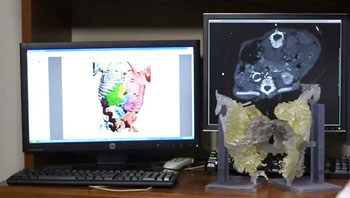3D Printing Aids Surgical Separation of Siamese Twins
By HospiMedica International staff writers
Posted on 13 Dec 2015
A new study describes how computerized tomography (CT) imaging and three-dimensional (3D) printing helped plan the surgical separation of conjoined twins. Posted on 13 Dec 2015
In the study, researchers at Texas Children's Hospital (Houston, USA) described a new technique they used to surgically separate conjoined twins from Lubbock (TX, USA) born in April 2014, who were connected from the chest all the way down to the pelvis. To prepare for the separation surgery, the researchers performed volumetric CT imaging with a 320-detector scanner, administering intravenous contrast separately to both twins to enhance views of vital structures and help plan how to separate them to ensure survival of both children.

Image: 3-D color segmentation of CT data with 3D model (Photo courtesy of Texas Children\'s Hospital).
They also used a technique known as target mode prospective electrocardiogram (ECG) gating to freeze the heart and get a more detailed view of the cardiovascular anatomy, while keeping the radiation exposure low. The CT imaging results were then printed as a color-coded physical 3D model with skeletal structures and supports made in hard plastic resin, and soft organs built from a rubber-like material. The models were designed so that they could be assembled together and separated during the surgical planning process.
The CT scans revealed that the babies' hearts were in the same cavity, but were not fused. They also revealed the existence of a “plane of separation” of the joined liver. To assist separation, the liver was printed separately, with major blood vessels depicted in white for better visibility. The surgical team then underwent an exhaustive preparation process leading up to actual surgery, performed on February 17, 2015, by a team of more than 26 clinicians, including 12 surgeons, 6 anesthesiologists, and 8 surgical nurses. The study was presented at the Radiological Society of North America (RSNA) annual meeting, held during November-December 2015 in Chicago (IL, USA).
“The surgeons found the landmarks for the liver, hearts and pelvic organs just as we had described; the concordance was almost perfect,” said lead author and study presenter Rajesh Krishnamurthy, MD, chief of radiology research and cardiac imaging at Texas Children's Hospital. “The 3D model also served another important function—helping the twins' parents, Elysse and John Eric Mata, understand the process. They said 'for the first time, we understand what is going to happen with our babies.’”
Related Links:
Texas Children's Hospital
3D model of conjoined twins – video














